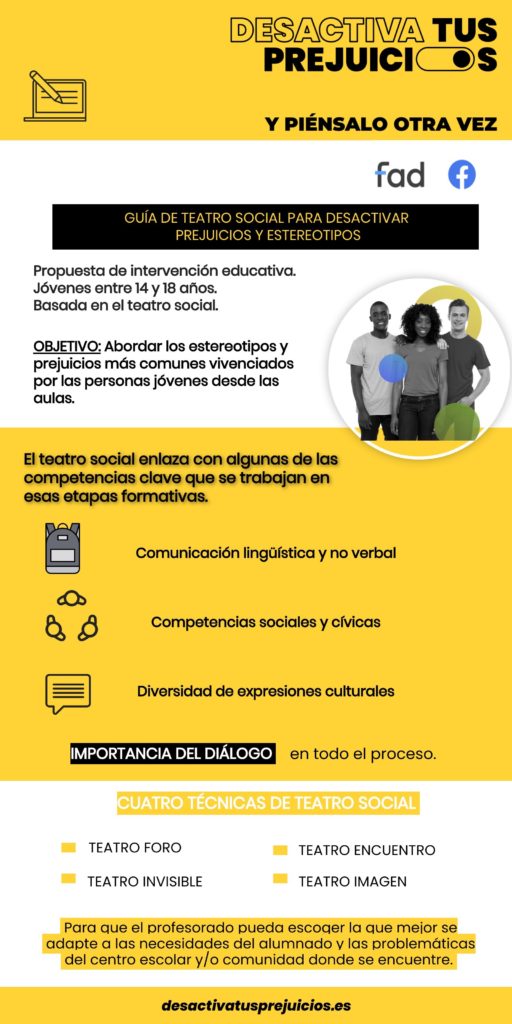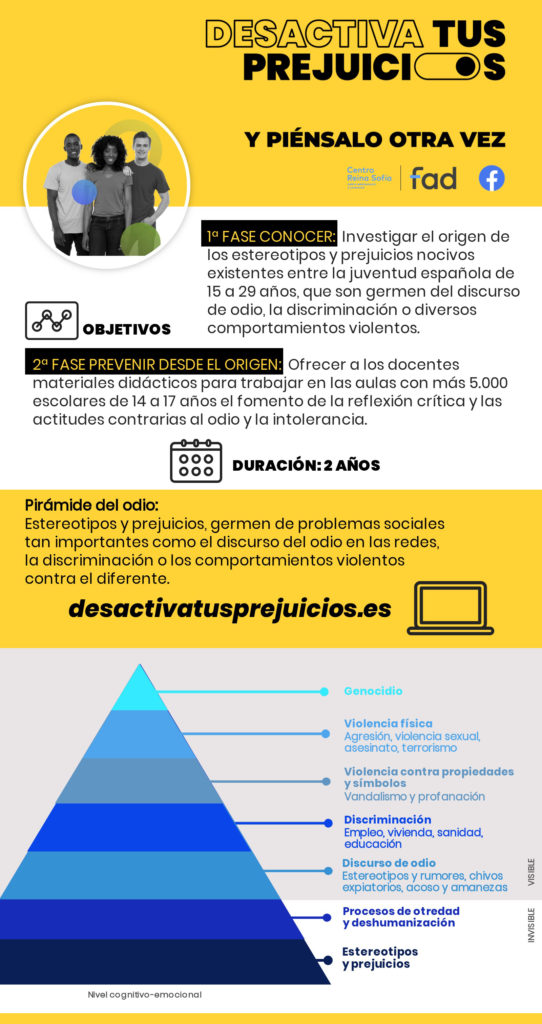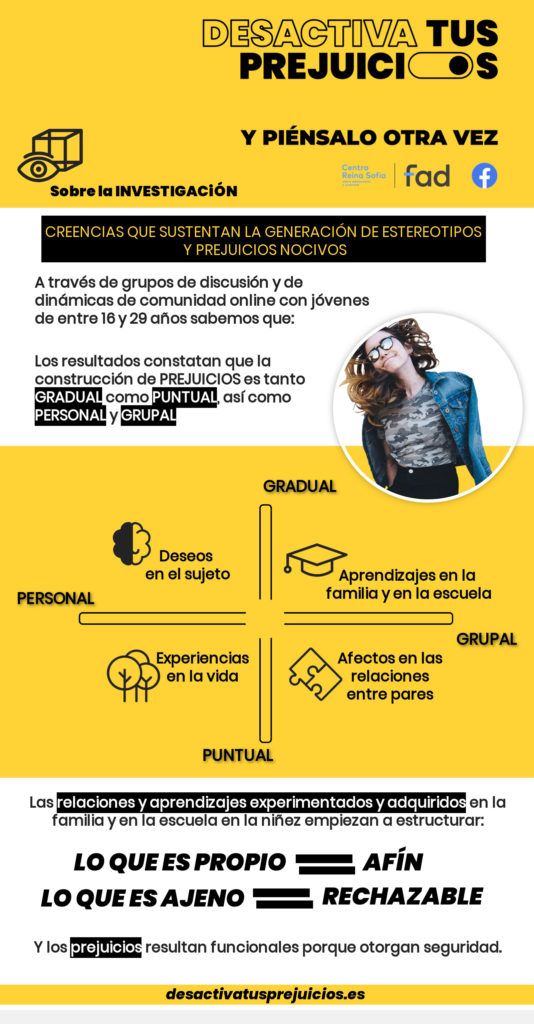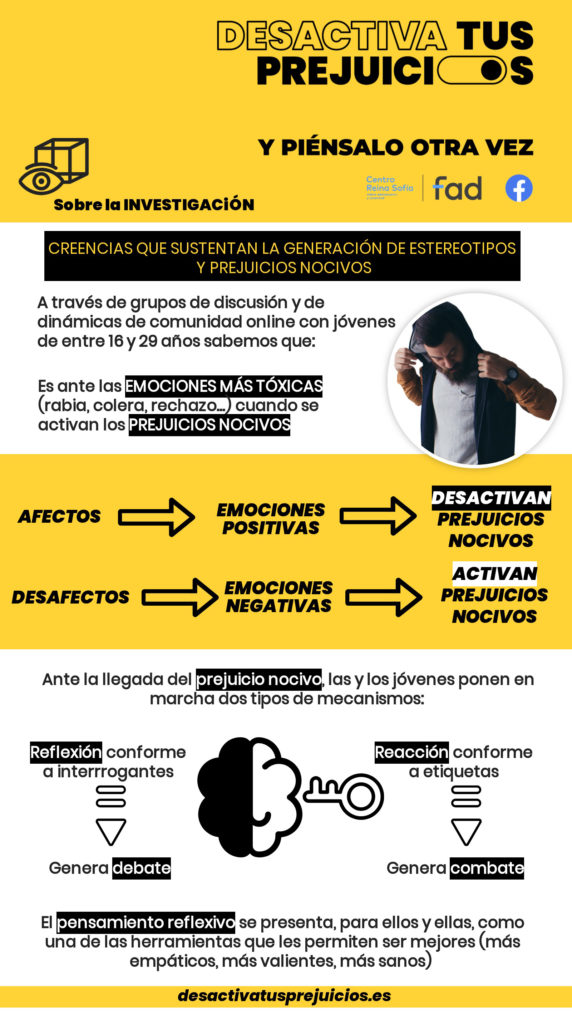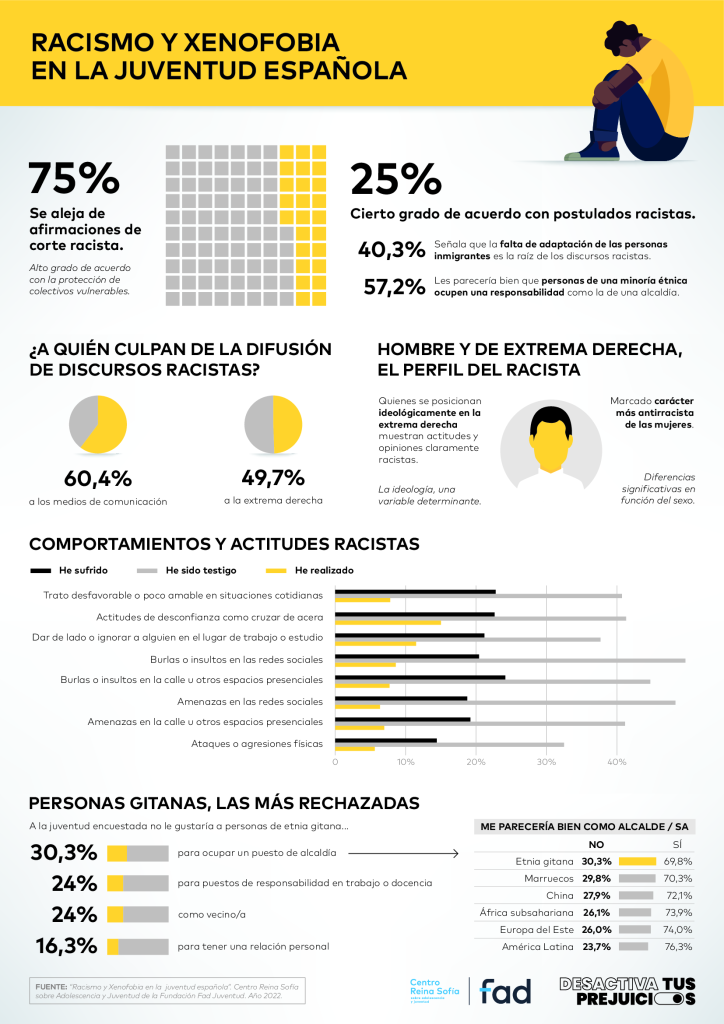Desactiva tus prejuicios
Desactiva tus prejuicios… y piénsalo otra vez aims to help adolescents and young people identify discriminatory prejudices and stereotypes—the foundation of discourses and behaviors that go against equality and respect—particularly those related to gender, sexual identity, racism, xenophobia, ageism, or any other form of discrimination.
To achieve this, the project promotes the use of performing arts in general, and theatre in particular, as a tool to identify and challenge these prejudices among adolescents and young people. In addition to a guide offering proposals for using social theatre as an educational resource, we organize a national contest open to youth theatre groups, providing a platform to showcase and give value to their efforts in fighting discrimination.
.
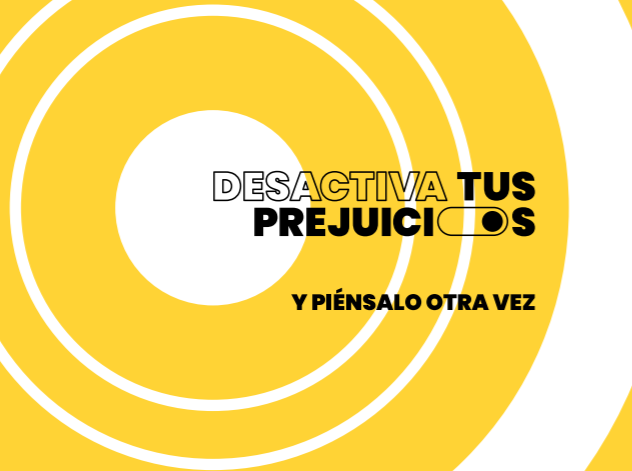
It's a project by


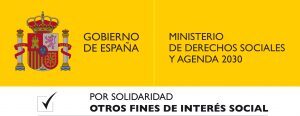

Contest

-
Vamos a contar mentiras
Winner
Escola Vedruna VallTarrassa -
Vamos a contar mentiras
Special mention
CP Cas CapiscolPalma de Mallorca
-
Sodermia
Sodermia is a play performed by adolescents between the ages of 14 and 16 who use theatre and circus arts as forms of artistic and social expression to make us reflect on the world around them. The performance is composed of a series of interconnected themes that shed light on the struggles faced by teenagers, such as image culture, prejudice, violence, inequality, discrimination, empowerment, and the value of friendship.
The play is the result of a long group work process, during which the young performers themselves chose the topics they wanted to address on stage. From the very first moment, the theatre is immersed in an enveloping, warm, and sensory atmosphere, where texts and monologues are accompanied by theatrical scenes, dance, and aerial acrobatics—adding an adrenaline-filled element to the stage with a transformative message for youth.
Sodermia is a cry of rebellion and pain from the adolescent stage—an age full of power, excitement, and hope for those who believe another world is possible. And if anyone can change things, it is undoubtedly young people and their commitment to the values of equality, solidarity, and justice.
The deep commitment, effort, and honesty of these young performers is evident from the very first moment of their performance, quickly establishing a connection with the audience and conveying stories of great value and powerful relevance.
Escuela de Circo Joven CircolivoPrado del Rey - Cádiz -
Freedom
FREEDOM highlights the need for our young people, when facing bullying, to have safe spaces where they can talk, express themselves, and free themselves from everything they are going through — in FREEDOM.
Asociación Cultural Athenea Teatro JovenValladolid -
Señales (que nuestros ojos las vean)
SEÑALES (QUE NUESTROS OJOS LAS VEAN), We want to talk about a difficult topic: ADOLESCENT SUICIDE, to highlight that when the thought of ending their life crosses a teenager’s mind, it doesn’t happen suddenly—rather, they give us SIGNS that we often don’t want to see or don’t want to believe. We are bringing visibility to this issue, which is becoming increasingly common among our youth.
Asociación Cultural Athenea Teatro JovenValladolid -
Bestiario
“Bestiario” It is a social theatre play about bullying among teenagers. Through a fantastical metaphor involving monsters, it explores fear, anger, and the possibility of transformation. It invites empathy, encourages facing pain, and recognizes the humanity behind both the aggressor and the victim.
Escuela IdeoSan Sebastián de los Reyes - Madrid
-
Mito de Medea. Seguimos luchando por la igualdad
To mark March 8th, our school’s theatre group has prepared a video based on the myth of Medea.
Year 431 B.C.
Medea represents an autonomous and unconventional woman, one who defies the ideal prototype of her time.
The myth of Medea portrays an issue that is still relevant today, as this great injustice has yet to be eradicated.
Year 2024
Medea lives within us
WE CONTINUE FIGHTING FOR EQUALITYIES Ramón y CajalValladolid -
No todo es Disney
«No Todo es Disney» It is a theatre play that critiques the infantilizing and heteropatriarchal patterns found in films that promote the mythification of romantic love, idealization, and power structures..
Centro Municipal de Información y Creación Joven de MarchenaMarchena - Sevilla
-
Estereotipos
An exhibition of stereotypes that generate prejudices among young people.
IES Joanot MartorellValencia -
Ésta también es tu película
A boy is waiting at the bus stop. Next to him, a young couple—a man and a woman. Jealousy escalates into abuse, and abuse into violence.
When is it time to take a stand?
Objective: to portray gender prejudices (and the resulting gender-based violence), harassment, and control fueled by social media.
Characters: Boy (14 years old), Man (18), and Woman (17).Ternura Teatro – Agrupación teatralMadrid -
Sin estigma
A project aimed at shifting collective thinking around the societal prejudices we hold toward mental health conditions. Prompted by the rising rates of mental health disorders in adolescence, the project is grounded in the goal of dismantling the barriers created by such prejudices and replacing them with socio-emotional strategies that foster a climate of coexistence.
Through this report, which documents the training experience of the theatre group alongside mental health experts, the students have ultimately developed scenes depicting exclusion in order to transform them—promoting socio-educational interventions through the forum theatre technique..
IES Luis García BerlangaCoslada – Madrid -
Citas
Every day it’s more common to meet people through apps—but are we truly tolerant enough to accept others?
What prejudices do we carry?
With this piece, we portray what usually happens—and what should happen if we were people free of prejudice.Escuela de cine NucineValencia -
Sketch vidas migrantes
The purpose of the script is to portray everyday situations of ethnic and racial discrimination faced by migrants when they arrive in Spain—a reality experienced by both young people and adults.
It is based on real-life stories of migrants living in different cities across Spain, including one story from a member of the youth group in our association.
The aim is to shed light on these experiences lived by young migrants, raise awareness among the general population, and work toward dismantling the stereotypes and prejudices directed at the migrant community.
Salamanca AcogeSalamanca -
La sociedad perfecta
We all like to think we're very tolerant and accepting of others—but the truth is, we're full of contempt and phobias toward anything we don't consider normative or acceptable within our own standards.
Escuela de cine NucineValencia
-
Frente de Acción para la Desactivación de prejuicios, el FAD
Los FAD – Frente de Ayuda a la Desactivación
IESO Publio López MondéjarCasasimarro – Cuenca -
Un mundo sin xenofobia
Stage fright
Ciudad – JovenMadrid -
Efímero prejuicios
Agarda
IES Cardenal Pardo de TaveraToro – Zamora -
El malentendido
4ºForo Boom!
CEIPSO Miguel de CervantesAlcorcón – Madrid -
Empecemos por aquí
Bombita Teatro. INS Joan Salvat Papasseit
INS Joan Salvat PapasseitBarcelona -
El penalti decisivo
Las Petunias
IES Luís García BerlangaCoslada – Madrid
Webinars Desactiva tus prejuicios
Research: Survey on Harmful Prejudices Among Spanish Youth
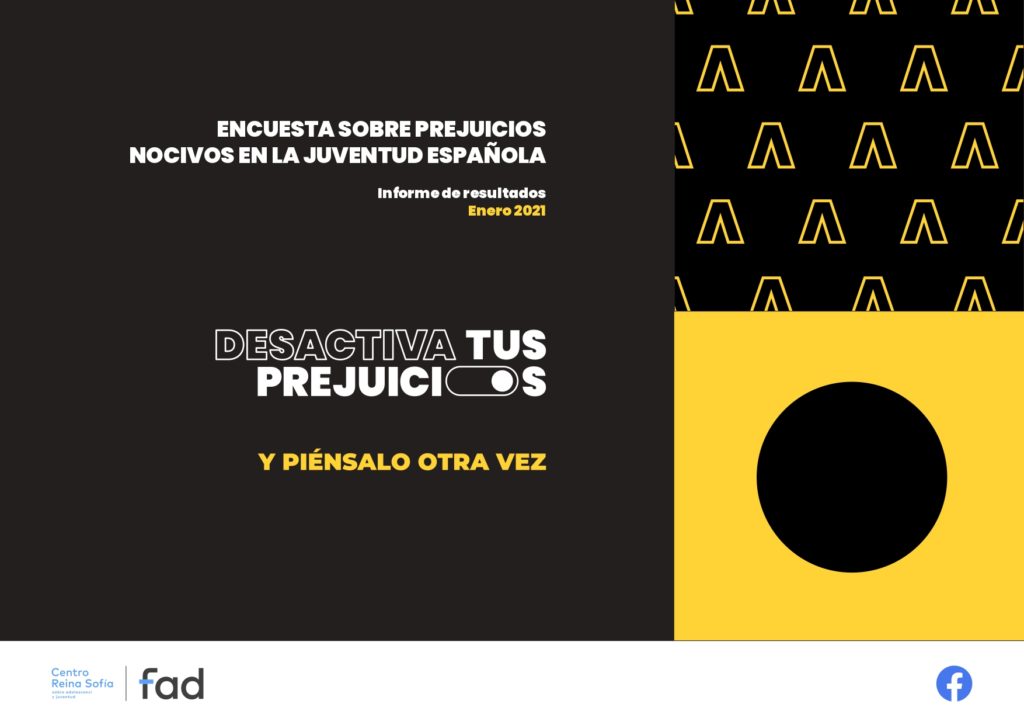
In this research, with the aim of contributing to the construction of a pluralistic, inclusive, and tolerant society that respects diverse communities and groups, we have focused on analyzing the issue of harmful stereotypes and prejudices. To do so, we adopted an innovative approach that considers both the reception and the expression of prejudice among young people, offering survey data that complements a previous qualitative analysis published in 2020.
Stereotypes and prejudices involve beliefs, generalizations, and judgments about other people or social groups based on their personal and physical characteristics, lifestyles, ideologies, gender identities, ethnic origins, or sexual orientations, among other factors. These are limiting beliefs that feed into young people’s vulnerability, as they affect not only their intimacy and personal identity, but also their ability to navigate and interact in public spaces.
.
Research: "Beliefs That Sustain the Generation of Harmful Stereotypes and Prejudices"
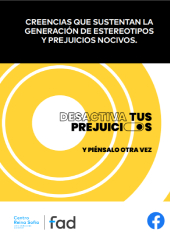
This research has a clear purpose: to understand the beliefs that, within the sample studied, sustain the harmful stereotypes and/or prejudices that influence how individuals relate to others—whether within their closest, more intimate circles or within broader social environments that involve a greater number of relationships.
The study succeeds in capturing the intersection between the particularities of their “biographical time”—which defines them in terms of ideas, emotions, preferences, and more—and the spaces where they interact with others, sharing their intimacy to varying degrees.
Research: Youth and Racism: A Study on Racist and Xenophobic Perceptions and Attitudes Among Young People in Spain
As part of our collaboration with Meta, we present this study on young people’s attitudes toward discrimination, racism, and xenophobia. As we already observed in the previous study, “Deactivate Your Prejudices: Survey on Harmful Prejudices Among Spanish Youth,” sociocultural diversity is identified as the main factor generating prejudice and stereotypes among young people. This is why we sought to explore this dimension further.
This report is based on a survey conducted among young people in Spain about racist and/or xenophobic behaviors, perceptions, and attitudes. It allows us to gauge the current state and evolution of these perspectives. The opinions and attitudes of young people are essential in understanding the development of discriminatory phenomena and how these may evolve in the coming decades.
As we always stress, we cannot speak of “youth” as a singular, homogeneous category, but rather of young people in a wide range of life circumstances and positions, where gender, age, material deprivation, or ideology create important differences in how reality is interpreted, how relationships are formed, and how social and personal challenges are identified.
The report shows that the prevailing discourse is largely non-racist. However, there is a minority—around 25%—who hold ambiguous views or express rejection toward certain groups or toward the implementation of some inclusion policies.
The study also addresses topics such as the impact of having experienced discriminatory behavior on the likelihood of reproducing it, and how the presence of sociocultural diversity in one’s close environment influences attitudes toward racism and xenophobia. In addition, several indices were developed to measure anti-racist attitudes, resistance to allowing ethnic minorities access to positions of power, and reluctance to engage socially with people from minority backgrounds.
Ultimately, identifying the areas where acceptance and support for a diverse society must be strengthened is essential to the process of eradicating racism and xenophobia—and this is the main goal of the project.


